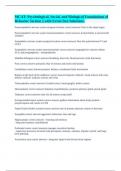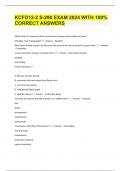MCAT: Psychological, Social, and Biological Foundations of
Behavior Section || with Error-free Solutions.
Parasympathetic nervous system synapses location correct answers Close to the target organ
Parasympathetic nervous system neurotransmitters correct answers Acetylcholine is used at both
synapses
Sympathetic nervous system synapses location correct answers Near the spine between T1 and
L2/L3
Sympathetic nervous system neurotransmitter correct answers preganglionic neurons release
ACh, and postganglionic - norepinephrine
Medulla oblongata correct answers breathing, heart rate, blood pressure (vital functions)
Pons correct answers primarily relay of sensory and motor information
Cerebellum correct answers posture, balance, coordinates body movements
Bumps on the back of the midbrain: correct answers Superior colliculi: visual sensory info relay
Inferior colliculi: auditory sensory info relay
Telencephalon correct answers Cerebral cortex, basal ganglia, limbic system
Diencephalon correct answers thalamus, hypothalamus, posterior pituitary gland, pineal gland
Thalamus correct answers relay for all senses except smell
Extrapyramidal motor system correct answers gathers information about body position -
proprioception and carries to CNS
Septal Nuclei (limbic system) correct answers one of primary pleasure centres in the brain
Amygdala correct answers aggressive behaviour, fear and rage
Hippocampus correct answers - learning and memory
- long term memory consolidation
Prefrontal cortex correct answers manages executive function
- supervises processes involved with perception, memory, emotion, impulse control, and long-
term planning
Association area correct answers - integrates inputs from diverse brain regions
,projection areas correct answers - sensory processing areas
Broca's area correct answers speech production (frontal lobe)
Wernicke's area correct answers language comprehension (temporal lobe)
Catecholamines correct answers Epinephrine, Norepinephrine, Dopamine - synthesized from
tyrosine
Neurulation correct answers - begins at 3-4 weeks' gestational age
- ectoderm overlaying the notochords begins to furrow - forms a neural groove surrounded by
two neural folds, furrow closes and forms the neural tube (becomes the CNS)
alar plate become sensory neurons
basal plate becomes motor neurons
Endoderm correct answers lining of digestive tract (epithelial cells), lungs, urinary bladder,
stomach, colon, liver, pancreas
Mesoderm correct answers skeletal muscle, bones, circulatory system, connective tissue, adipose
tissue, dermis
Ectoderm correct answers CNS, PNS, epidermis, hair, nails, lens of the eye
Rooting reflex correct answers infant turning of the head toward a stimulus that touches its cheek
Moro reflex correct answers infants react to abrupt movements of the head by flinging out their
arms, then slowly retracting their arms and crying - normally gone by 4 months
Babinski reflex correct answers - toes spread apart when sole of foot is stimulated
Weber's law correct answers states that there is a constant ratio between the change in stimulus
magnitude needed to produce a jnd (just noticeable difference) and the magnitude of the original
stimulus
- aka a ratio/percent rather than a numerical value (jnd)
Catch trial correct answers signal is presented
noise trial correct answers signal is not presented
absolute threshold correct answers minimum intensity of a stimulus we can sense (not
necessarily perceive)
pathway light travels through the eye correct answers cornea (focuses light) - anterior chamber -
iris - posterior chamber - lens - vitreous humour - retina
, optic chiasm correct answers nasal optic nerve fibres cross, lateral fibres continue and meet up
with decussated nasal fibres to form the optic tract
Visual pathway correct answers Optic nerve - optic chiasm - optic tract - Lateral Geniculate
Nucleus of Thalamus - visual cortex
- also inputs to superior colliculus
Parvocellular cells correct answers detect shape
- have very high colour spatial resolution
Magnocellular cells correct answers detect motion
have high temporal resolution
Pathway of sound (ear structures) correct answers Pinna (auricle) - external auditory canal -
tympanic membrane (eardrum) - ossicles (malleus [hammer], incus [anvil], stapes [stirrup]) -
oval window or round window - membranous labyrinth (cochlea, vestibule, semicircular canals)
Vestibule correct answers utricle and saccule are sensitive to linear acceleration
- detected by hair cells covered in otoliths that resist motion as body accelerates - bending -
signal
Semicircular canals correct answers sensitive to rotational accleration
- sensed in the ampulla by hair cells
Hearing correct answers organ of corti bathed in endolymph and composed of thousands of hair
cells sense vibrations and relay signal to brainstem via vestibulocochlear nerve - ascend to
medial geniculate nucleus then to auditory cortex - or superior olive (sound localization) - or
inferior colliculus (startle reflex
Pacinian corpuscles correct answers respond to deep pressure and vibration (fires when pressure
is first administered and when it is removed)
Meissner corpuscles correct answers respond to light touch (fire when touch is first administered
and when it is removed)
Merkle discs correct answers respond to deep pressure and texture (fire to constant pressure)
Ruffini endings correct answers respond to stretch (fire to constant pressure)
Free nerve endings correct answers respond to pain and temperature
gate theory of pain correct answers proposes that there is a special "gating" mechanism that can
turn pain signals on or off, affecting whether or not we perceive pain - spinal cord can
preferentially forward signals from other modalities (pressure, temp)





